#minimalism is still trending for 2024
Explore tagged Tumblr posts
Text
If airports weren’t already a hellscape, TikTok has found a way to make them worse. Welcome to airport theory, a viral delusion that suggests you can roll up to the airport 15 minutes before boarding, waltz through security, and still make your flight with time to spare. No stress, no waiting, just pure main character energy.
TikTok creators like Michael DiCostanzo (@michael.dicostanzo) swear by it, documenting their dashes through high-traffic hubs like LAX, Atlanta International Airport, and post–Super Bowl New Orleans. Some viewers are sold. Others are calling BS.
“So you had PreCheck, didn’t check a bag, and were at the nearest terminal? Now let’s do it when it’s not the optimal situation,” one user commented. And, sure enough, the internet is also littered with failed attempts—videos of forlorn TikTokers watching their flights take off without them, their carry-ons full of regret.
It’s a fun fantasy, which explains why “airport theory” has racked up over 400 million views on TikTok. Unfortunately, the the Transportation Security Administration doesn’t care about your viral moment. The national average wait time for security was 27 minutes, 16 seconds in 2024. And if you’re flying out of a notorious bottleneck like JFK, Orlando International, or Chicago O’Hare, it’s closer to 40 minutes. Google searches for “I missed my flight what do I do” have spiked 70 percent in the past month, per Google Trends. It’s not hard to connect the dots.
Here is your sad reality check: Airlines still recommend arriving at least two hours before a domestic flight, three for international. Sometimes that buffer feels like overkill. But would you rather rush through the airport with your heart racing or have a few minutes to find your gate, grab a bag of overpriced whatever, and scroll TikTok watching other people miss their flights? That sounds like a much better airport theory to us.
Airport Hacks That Actually Work
The best way to get through airport security unscathed is to move like you’ve done this a hundred times before. A little planning, the right gear, and skipping social media stunts will get you from curb to gate with minimal stress.
Time It Right
Travel off-peak. According to CheapAir, Tuesdays and Wednesdays are often less crowded. Early flights between 5 and 8 am and red-eyes (after 9 pm) tend to have fewer passengers.
Check TSA wait times in advance. The My TSA app (iOS, Android) provides real-time security line updates at major airports.
Get the Right Apps
Download your airline’s app for mobile boarding passes and real-time gate updates.
Get TSA PreCheck. Some credit cards even cover the fee. Global Entry (available at select airports) includes PreCheck and fast-tracks reentry into the U.S. Or consider Clear Plus, which uses biometric scans to bypass ID checks.
Use Mobile Passport Control app (iOS, Android) to submit your customs info beforehand for faster reentry to the US.
Pack Smart
Start with an empty bag. Double-check TSA-restricted items list to avoid accidentally smuggling contraband.
Use a clear toiletry bag. The Calpak Clear Cosmetics Case for $85 is an upgrade from the ziplock bag. If you’re worried about TSA’s liquid restrictions, switch to toothpaste tablets like biöm’s Nobs and use reusable travel bottles. I'm a fan of Reis' Refillable Travel Container set, but I've also used travel kits from Amazon for under $10, and they work just as well.
Go carry-on only. The Away Carry-On for $275 is our favorite, but if you want to avoid Away’s baggage, try Monos ($255) or July ($295).
Track your luggage. If you check a bag, stash an AirTag inside for iPhone users or a Chipolo One Point ($25) or Card Spot ($29) for Android.
Dress for Efficiency
Empty your pockets before security. Stash everything in your carry-on instead of fumbling at the checkpoint.
Keep metal jewelry, watches, and belts in your bag until after screening.
Avoid boots or high-tops. Slip-ons like Allbirds' Tree Runners for $98 and the Rothy’s Driving Loafer for $189—we've raved about them in the past—make security a breeze. If you’re not planning on sprinting through the airport, the Bearpaw Martis Slippers ($70) are ultra-comfy.
Skip bulky outerwear. Coats, hoodies with big pockets, and anything with excessive zippers just slow you down. If you have PreCheck, you can usually keep your shoes, belt, and light jacket on.
Stay Organized
Snap-on Phone Stand & Wallet
If you have an iPhone, invest in a MagSafe wallet to avoid digging through your bag for an ID. Some of our favorites include Casetify ($38), Moft’s Snap-On Phone Stand & Wallet ($30), and ESR HaloLock Power Bank Wallet ($80), which works as a power bank, wallet, and phone stand.
Get a checkpoint-friendly laptop backpacks. Lay-flat designs like Peak Design’s Outdoor Backpack (available in 25L and 45L) speed up screenings.
40 notes
·
View notes
Text
2024-25 Season Prediction Survey Results
Read below or read a better formatted version here
The second PWHL season looms heavy on the horizon, and with preseason camps underway, the prospect of change, a new season with new storylines and new team names and logos and new players, haunts us all. We may not all be sports experts, but after watching the first season for months and eagerly awaiting the second, we all have our own ideas of how season two might go. Whether they’re logical ideas or not will be seen upon the future, but I, lover of data and spreadsheets, decided to gather up all your opinions and predictions of how season two will go, from the biggest honor (The Walter Cup) to random questions regarding trades and penalty minutes
Team Predictions -
This was the easy part of the form. Minimal prior knowledge, you didn’t even need to know the team names because I put them all in as multiple choice questions. Hypothetically everyone could have just picked randomly and I wouldn’t be any the wiser. That being said, some interesting trends emerged from you folks, some predictable and some less so.
Walter Cup Winners: Boston Fleet or Montreal Victoire (35.3%)
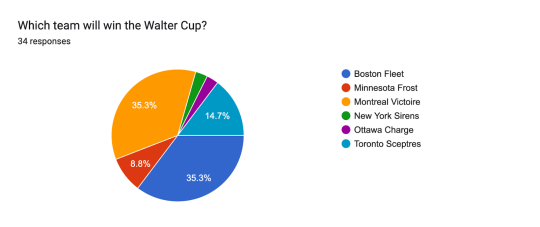
This was probably one of the closest races beneath the team with only about a single vote difference between Boston winning it all and Montreal winning it all at any one time. As an entirely unbiased Boston fan and casual Montreal enjoyer, I think this prediction is definitely founded in something. Montreal and Boston project to be two of the stronger teams, but I also think I’m biased if only because of how many Montreal and Boston fans I see in comparison to other teams. With all that being said, I’d be disappointed but not surprised if some other less represented team (Seriously does no one believe New York can win? Even Ottawa got a single vote and y’all really hated Ottawa) wins it going away after a hot season. But as my father always says, that’s why we play the game and this game/series in particular is quite a far ways away.
Walter Cup Runner Ups: Montreal Victoire (35.3%)
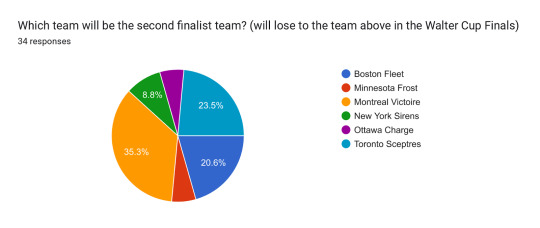
Honestly, I was expecting pretty similar results for this question as the question above, after all if the general consensus is that one of those two teams will win the cup, then one of them would have to lose it, right? Well Montreal was right up there, but unexpectedly Toronto came in second with 24% of people having enough faith in Toronto getting to the finals and then very little faith in them actually winning it, girlfailures that they are. Montreal tied with them to get second in the cup, followed by Boston (please god don’t let it come to that I don’t think my heart could take two years in a row) and then the mish mash of the Sirens, Frost, and Charge.
First in the standings: Toronto Sceptres (32.4%)
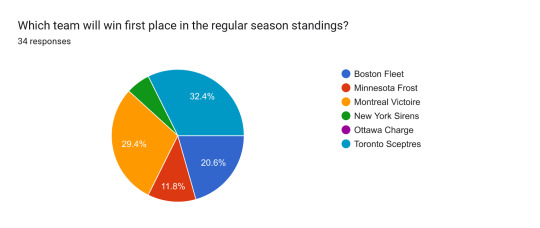
So Montreal was leading this right up until I was actually writing and then I had to completely change my paragraph mid writing which was so much fun and definitely not irritating at all, but Toronto overtook Montreal for first, aiming for that repeat first in the standings and dare I be speaking sacrilege against the Victoire (who I do like more than the Sceptres) I honestly think they have a better chance. Like a 45% chance vs. a 40% chance. Boston carried up third place in voting and as much as I love the Fleet I think lots of things would have to go right for that to happen (another stunning season by Frankel, more consistent offense, an actual power play, so on and so forth).
Additionally, as much as I hate to say it, I think we’re seriously underselling Minnesota, just because they made some inadvisable choices during the off season doesn’t mean they still aren’t largely the team who won the Walter cup and has theoretically gotten better during the offseason. Then again, I’d be as happy as anyone to see them crash and burn a little bit so it’s all speculatory. New York got a grand total of two votes but I’m secretly rooting for them to surprise some people. Ottawa got none, but we can cover that in the next section.
Last in the standings: Ottawa Charge (52.9%)

Guys. Guys, really? Ottawa fans, I am begging you, come represent your team because this is embarrassing. Like I don’t know much about what Ottawa’s been up to other than rebuilding the Czech National Team (shout out to Carla Macleod I am manifesting you knowing what you are doing). Like they weren’t bad last year, they were second in goals for, and they did lose a bit but they had tons of overtime losses which means they were in the games. Hell, they were very nearly in the playoffs, they were in the same category as Minnesota and Boston, the two finalist teams! Apparently my unpopular opinion is that Ottawa isn’t going to suck (They hopefully have two solid goalies now so Masch won’t be overworked, they signed some good players, I feel like I’m going crazy.) Otherwise, there’s not much notable in this section other than some doubt about the Sirens and the Frost (lord let it be the Frost /j) but shoutout to the one person truly going against the grain and saying that Montreal is gonna get dead last, I applaud your bravery.
The Four Playoff Teams:

This question was a little less straightforward so we’re gonna split it into three sections. The (Predicted) Shoe-ins, The Contenders, and Ottawa.
The (Predicted) Shoe-ins -
The Sceptres, the Victoire, and the Fleet all had about 30 votes with nearly 90% of respondents selecting them each as one of the potential playoff teams. This fits pretty well with the previous votes of the Walter Cup winners and runner ups, so I wasn’t too surprised at any of these. All of these teams should have a decent shot at the playoffs and my own mostly unfounded misgivings about the Sceptres aside, this is all pretty reasonable and I largely think there’s a good chance that this is how it goes..
The Contenders -
The Frost and the Sirens were pretty evenly matched, about half of y’all voted that they’d be one of four playoff teams and I generally agree that they both have a pretty good shot at the playoffs so there isn’t much to talk about here. I’d personally be more excited for the Sirens to make a run at the playoffs, I think they have a chance to be good after last season and hopefully put some things together over the summer, but we shall see.
Ottawa -
You know I already wrote a whole ramble about this and since then Ottawa beat Boston 6-1 in the preseason and I think they heard how little faith you guys had in them and decided to take it out on my team. That’s all I’m gonna say on that.
The Trade Predictions:

These answers were definitely a bit less clear cut due to the nature of the question, after all it’s a lot easier to say who you think will be good than try and get into the head of GMs and coaches, but a few trends emerged nonetheless. The Frost, the Sirens, and the Charge all got 19 or 20 apiece and I think it makes a bit of sense. After all the Sirens and the Charge seemingly stand the most to gain through trade having missed the playoffs, and from later responses those who voted Minnesota were manifesting a Britta Curl trade which I’ll refrain from judging at the moment. I will say I’m a bit surprised that less people voted for Boston, after all unless my memory is entirely wrong they had the most trades over the course of last season and seem to hold very few qualms about it.
0.500+ Winning Percentage: Montreal Victoire (84.8%)

Guys, I respect this take, I’m 90% sure this was one of my votes for an above .500 team as well, but may I speak a little bit of heresy against the Victoire? Like they’re gonna be good, I don’t have doubt in that, but I don’t know if they’re gonna be that decisively good. They’re a bit injured which could lead to a rocky start and do we all still remember how much they relied on those top few players especially in the playoffs? I’m pretty sure in the Boston series their fourth line may have gotten less than ten minutes overall which I’m not an expert on hockey but isn’t a whole thing about balancing ice time and having solid lines all the way through so your stars aren’t having absurdly long nights (shout out to Erin Ambrose you deserve a gun)?
Otherwise this follows the general trends of the playoffs with a bit more faith in the Frost than in the Sirens, a reasonable amount for the Fleet and Sceptres, and absolutely none in Ottawa which I think we’ll all come to regret but I’ve said my piece about that already so I won’t beat a dead horse into the ground.
Higher Goals For than Goals Against: Toronto Sceptres (68.8%)
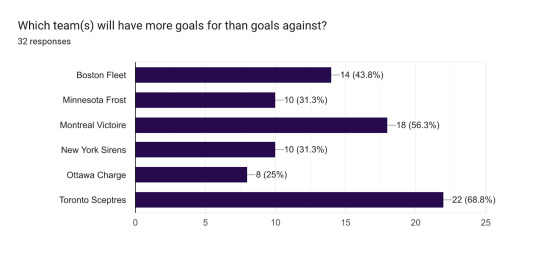
This risks getting into actual smart people hockey stuff that I am by no means an expert in, so I won’t spend too long other than to just share the results. Toronto and Montreal are the only two teams with a confidence rate of over 50%, followed by Boston, Minnesota, New York, and Ottawa. I think it’s interesting to think about potential offensive numbers but really can’t speak much to how accurate these have the chance of being because my main reaction is “huh yeah that’s a statistic people can make predictions on”
Player Predictions -
This definitely was a lot less definitive on almost all fronts, and I joked while advertising this that you could just type in MPP for all the answers and get half of them right, which seems to be the approach that some of you took. It’s fair, but expect a lot of repetition looking at these charts due to that because she is just that pervasive. I’ll try to mention as many players you guys picked as possible but you might have to look at the charts because I am neither an expert in all players nor a good enough writer to say anything other than “Yeah that’s certainly a player”
Above 1.00 points per game played: Marie Philip-Poulin (13 votes)
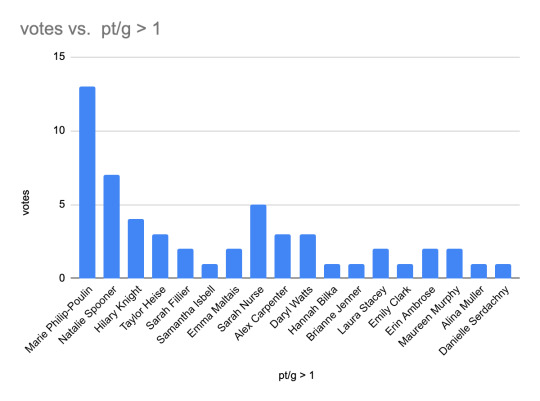
And here is the start to our MPP sweep, starting strong off the bat, about half of the 26 answers to this question included her which makes sense. She was second only to Natalie Spooner last season, with 1.1 pt/g and unless something weird happens I see no reason to suspect otherwise from her. I honestly didn’t expect as many other players to be suggested, after all it was only Natalie Spooner and Marie Philip-Poulin which makes sense, it’s an impressive statistic, but everyone seemed to have their favorites. Sarah Nurse was one player who hasn’t really been on my radar but you guys seem to like her, for this question and a bunch of other ones. I personally am partial to a Hilary Knight comeback season from this list but would be interested to see anyone make that jump.
In the Top Ten Points Getters: Marie Philip-Poulin (15 votes)
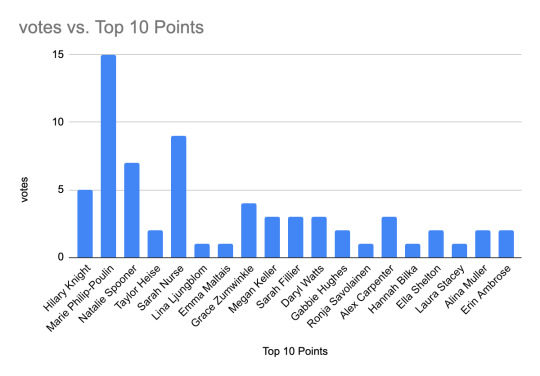
Everyone raise their hands if they’re surprised MPP won this in a landslide, oh wait literally no one is surprised I could have told you this when it was literally only my vote on the board. You’ll learn very quickly that oftentime the runaway winner of these simple questions aren’t really the interesting ones, it’s everyone else that got nominated that you can really dig into. Everyone who got top 10 last year, 18-27 points was up here in this list except Brianne Jenner and Katerina Mrazova which I’m chalking up to you guy’s Ottawa hate. Shoutout to Tobi and the one other person who voted for Gabbie Hughes and also Ronja Savolainen, you are the real ones rooting for the Charge.
Also I don’t know if it’s because with Natalie Spooner just kind of ruled the world coming out of Toronto I was completely blindsided by Sarah Nurse on most of these questions sorry Nursey I forgot you existed a little bit hopefully the Toronto girlies don’t tear me apart for that one.
PIMPG Over 1.00 Minutes: Abby Roque (16 votes)

The certainty of the questions ticks up by one for the next few and as much as everyone believed in MPP being awesome overall, one more person believed in Abby Roque being a criminal on skates and/or overly penalized, I didn’t leave room for that distinction. Tereza Vanišová earned the dubious distinction of second place but only with 6 votes and Emma Maltais earned third with a measly 3. Not a ton of Rookie representation here but I’ll be interested to see if any of this draft class take up this mantle. Also shoutout to the two people who voted Kaleigh Fratkin despite her not playing that’s so real and valid of you.
Save Percentage Over 0.920: Aerin Frankel (17 votes)

With the most votes of any player for a single category, Aerin Frankel, The Green Monster, love of my life and the blockade of the Boston Fleet, absolutely swept this category. I might have been thinking this in my head, but it’s good to see my Frankel love reaffirmed for the upcoming season because she deserves it all. And maybe a gun if Boston decides to have a few repeat performances from last year (cough two fifty+ save games in a row cough). The goalie questions have an inherently smaller pool so there were fewer surprises because as a certified goalie lover I try to keep tabs on the situation in net across the league. I’m shocked ARD didn’t get as much of a nod here from Montreal fans but suppose the appeal of Montreal is dissimilar to Boston in that regard as you theoretically have a consistent offense.
20+ Games Started as a Goalie: Aerin Frankel (16 votes)

Honestly I’m surprised Maschmeyer didn’t run away with this question because if it’s who I’d like to see start 20 games and do wonderfully it’d definitely be Frankel but I think with the possible addition of Klara Peslarova Boston shouldn’t be overly reliant on her with Soderburg and potentially Peslarova to back her up. I suppose it might be overwhelming faith in Gwyneth Phillips to be a solid number 2 in Ottawa but she wasn’t that represented in other goalie questions so maybe it was just an oversight considering Masch had the most starts of any goalie in the league last year. More interestingly, I respect the one person who refrained from answering and basically said that there’s so much depth in the league that no goalie will get 20 out of 30 starts. I’m not sure if it’s accurate, but the depth is real so it’s possible.
Billie Jean King (MVP) Nominee: Marie-Philip Poulin (10 votes)

And now we’re officially back in MPP territory and I’m not gonna spend too much time breaking this down because yeah. If Poulin has a repeat performance from last season and Spooner’s out for a significant portion of the season on LTIR, it’s her award to lose. But let’s look at some of the people you think she has the chance to lose it to. Once again you guys are on the Sarah Nurse train and you know what I support. Seeing the team ratios, lots of Toronto, a smattering of everyone else, no Ottawa, is definitely interesting but I’m not nearly smart enough to make conclusions as to what that means so I’ll leave it up to you to decide. (Something something teams with depth might have less obvious candidates if they’re all kicking in?)
Forward of the Year Nominee: Marie-Philip Poulin (10 votes)
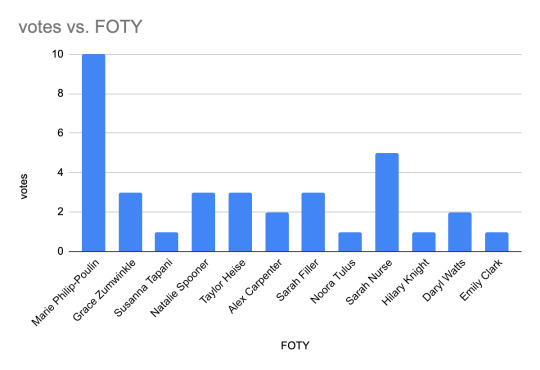
Wow. MPP for forward of the year, who possibly could have predicted this. Definitely not me. And yes, you all are probably right but that’s not interesting! That’s not fun and cool and interesting so let’s move on. More Sarah Nurse love in this house and I think I can confidently say there aren’t very many of you confident in a repeat performance from Spooner/think her injured status will prevent her from potentially making this list. It’s a bit more prominent but there’s definitely a big Daryl Watts faction of supporters and honestly I endorse this. I might not be a huge Toronto girlie but I always have a soft spot for players who move teams and she just seems like a very easy person to root for. I just hope she doesn’t do too well against Boston this Saturday <3
Defender of the Year Nominee: Ella Shelton and Erin Ambrose (7 votes)

See isn’t this fun, isn’t this interesting, a tie for first place and none of them are named Marie-Philip Poulin! (ignore the fact she isn’t eligible) Honestly, I think Ella Shelton and Erin Ambrose are the obvious but objectively correct candidates. They were both nominated and both deserving but I think Shelton was a little robbed, after all she was second in points for her team as a defender and fifth yes that’s right, fifth place for points overall. But alas Erin Ambrose is a titaness and also deserved the award so that’s not the point. The point is I think I’m slightly biased towards Shelton between our two winners. As our runners up, we’re really feeling that Sophie Jaques love and I might be anti-Minnesota but I can’t bring myself to be ant-Sophie Jaques. Of course I endorse Keller (Go Fleet!) and can’t say I know enough about the rest of these players defensively to speak definitively on their chances.
Goalie of the Year Nominee: Aerin Frankel (13 votes)
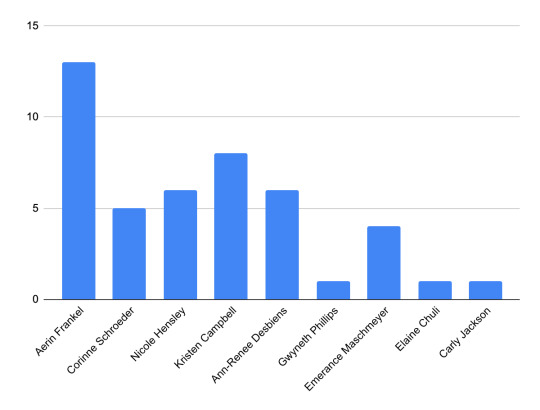
Peace and love on planet earth there’s not much to say that I didn’t already say in the save percentage or games started section so I won’t dawdle too much here other than to say that there was a little less variation of who you thought would be nominated versus who you thought would have a good season (starting 20+ times, high save percentage). You guys tend to stick with proven goalies, which makes sense and I can’t see any place I’d disagree other than to say I think that if Corinne Schroeder keeps up her save percentage (higher than Soupy last year) and New York lets her see less of a volume of shots (she saw about 31 per game as compared to Campbell’s 24) by actually playing defense, she could separate a bit from the other goalies in the league. I’m always rooting for Aerin Frankel and think she got robbed last year, so if she stays the Green Monster she was last season I think she has a really good chance.
Rookie of the Year Nominee: Sarah Fillier (12 votes)
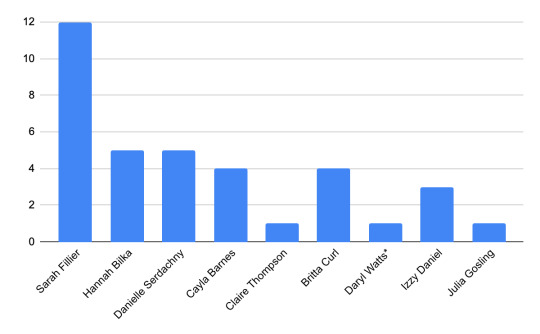
This really reaffirmed for me that most of us have absolutely no clue anything about the depth of this rookie class. Of the nine players named, ⅔ of them were the first round of the draft, one of them isn’t even a rookie (Sorry Daryl Watts you won’t be getting this piece of hardware), and Curl and Daniel were second and third round picks respectively. Meanwhile over 20 rookie skaters got points in the preseason games alone and only Serdachny and Fillier from this list got more than 1 point. The rest of those seven players were all but forgotten. And I get it, preseason is preseason, but my prediction is we’ll have a few unexpected standouts who really break out in the league when no one really saw them coming. I don’t think Sarah Fillier will be snubbed with nominations, her preseason hatty proved that she’s coming out on all cylinders, but I wouldn’t be surprised if the other two are people not listed here. We shall see.
Significantly Better Year (Pt/G increased by at least 0.4): Hilary Knight (7 votes)
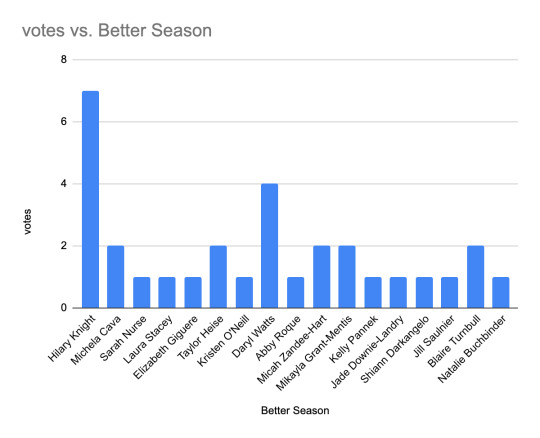
Listen, I might be biased as she is the Captain of the Fleet (which sounds so cool and I do need art of her in a pirate uniform immediately if not sooner) but I personally am rooting for a Hilary Knight revenge tour. I think we saw it at the rivalry series and in the single preseason game she graced the ice with her presence, but I think she’s the type of player who underperformed last season and is now prepared to rip the league a new one. This was definitely one of the more varied questions with most candidates getting 1 or 2 votes so I’ll let you make your own opinions though I will say a lot of you are on the Daryl Watts train and think she’ll find her footing in Toronto. My one note is I’m not sure if some of you got the question because there are some candidates here (Sarah Nurse most notably) who had great and/or good seasons (above 0.5 points per game) and going up by 0.4 or more would mean they’d become transcendent players on the same level as the Spooners and Poulins of last season. I’m not saying you’re wrong, I’m just saying there’s only so high players can go reasonably.
Involved in a Trade: Britta Curl (2 votes)

If the last question was a wide field of answers, this was a complete crapshoot. Aside from what I assume are two Minnesota fans hoping to dump Britta Curl on some other team, everyone else seems to be selected at random, so I won’t bother with any conjecture, you can observe and draw conclusions for yourself.
#pwhl#pwhl lb#pwhl boston#boston fleet#pwhl minnesota#pwhl montreal#pwhl new york#pwhl toronto#pwhl ottawa#montreal victoire#minnesota frost#ottawa charge#new york sirens#toronto sceptres#hockey#woho#professional women’s hockey league#statistics! and data!
27 notes
·
View notes
Text
Also preserved in our archive
By Jess Thomson
Samples from wastewater in several U.S. states have tested "very high" or "high" for levels of the virus that causes COVID-19.
SARS-CoV-2 levels were found by the U.S. Centers for Disease Control and Prevention (CDC) to be "very high" in New Mexico for the period November 10 to November 16, 2024, and "high" in Arizona, Kentucky, Minnesota, Oklahoma, Pennsylvania, and South Dakota.
"Moderate" levels of the virus were detected in Colorado, Idaho, Maine, Maryland, Ohio, Oregon, Rhode Island, Utah, and Wyoming.
More From Newsweek Vault: What Is a Health Savings Account?
19 states had "low" levels detected, while "minimal" levels were spotted in 14 states and D.C.
(follow the link for an interactive map!)
However, the data from Arizona, Oklahoma, South Dakota, Mississippi, and Ohio all have limited coverage, meaning that it is "based on a small segment (less than 5 percent) of the population and may not be representative of the state/territory," the CDC explained. North Dakota also has no data for this period.
The week prior, between November 3 and November 9, "very high" levels of viral activity were also detected in New Mexico, with "high" levels being found in Montana, Wyoming, and South Dakota.
Many viruses are excreted in feces, even if the infected individual has no symptoms. This includes SARS-CoV-2, which has been shown to be present in the gastrointestinal tract of infected individuals. Once in the wastewater system, viral particles, or fragments of their genetic material, are carried to treatment plants. Testing of this wastewater can detect these fragments, providing valuable information about the presence of the virus in a community.
By regularly testing wastewater, the CDC can track trends in viral levels, helping public health officials assess whether COVID-19 cases are increasing, decreasing, or remaining stable in a community.
"Wastewater monitoring can detect viruses spreading from one person to another within a community earlier than clinical testing and before people who are sick go to their doctor or hospital. It can also detect infections without symptoms. If you see increased wastewater viral activity levels, it might indicate that there is a higher risk of infection," the CDC explains.
CDC data shows that COVID virus levels have hugely dropped since the summer months, with most regions still trending downwards. However, there is a slight uptick in virus activity in the Northeast and the Midwest
As of November 16, subvariant KP.3.1.1 made up 34 percent of COVID-19 cases in U.S. wastewater over the previous two weeks. New XEC variant made up 21 percent, KP.3 made up 18 percent, JN.1 made up 13 percent, and "other" made up 15 percent.
"There is no evidence, and no particular reason to believe, that XEC causes different symptoms than all the other SARS-CoV-2 currently in circulation," Francois Balloux, a profesor of computational systems biology at University College London in England, previously told Newsweek. "XEC is not expected to cause more (or less) severe symptoms than other lineages currently in circulation."
#mask up#public health#wear a mask#covid#pandemic#wear a respirator#covid 19#still coviding#coronavirus#sars cov 2
29 notes
·
View notes
Text
One Short Day in the Emerald City: My Review of Wicked (2024)
For my first post, I think it would be perfect to kick it off with a movie review - which, by the way, this blog will be 90% filled with lol - so here it goes!

It's been more a week since my friends and I saw Jon M. Chu's Wicked (2024) in theaters. It was opening weekend so you can expect the cinemas to be jam-packed. But probably my favorite part pre-movie (aside from the popcorn!) was the ongoing trend of people showing up at the cinemas in costume or following the theme of the movie. This trend is one of the reasons I love going to the cinemas versus just streaming it at home. So imagine, we arrived about 15 minutes before the start and the lobby & popcorn lines were filled with people wearing pink & green. I myself was wearing a green knitted top and pink shorts! As funny as it sounds, it literally gives life to the meme of the cinema ticket person asking what movie the person is seeing and the camera pans to the moviegoers in costume. Absolutely hilarious. (And I thank Avengers: Infinity War for starting this trend & the Barbenheimer craze for heightening it!)
Also, I wanted to add that this experience was personally special because I bumped into my favorite high school teacher of all places! We haven't seen each other in years, so this was really a delight.
(By the way, this may be a spoiler-ish review when it comes to the technicalities but in terms of the story - unless you haven't seen the Broadway musical or seen the 1939 film, then I don't know what to tell you lmao)

Now on to the movie itself... The title card!!! From there, I knew right away that this film was not just going to pay homage to the timeless classic that is The Wizard of Oz (1939), but to create a new world of Oz for this generation without losing the magic of the original. We see right away the iconic quartet walking down the famous yellow brick road, snippets of "Somewhere Over The Rainbow" in the music, and the dazzling Emerald City. For a semi-theater kid (I say semi because I grew up with musicals, just didn't get involved with acting in any of them at school or anything lol), I was already having goosebumps in the first few minutes.
Of course, Wicked is known for its many iconic songs that legends Idina Menzel and Kristin Chenoweth have made timeless, but my personal favorites are "What Is This Feeling?", "Dancing Through Life", "For Good", and of course, "Defying Gravity". Now obviously with the exception of "For Good", the other three musical numbers really lived up to expectations. "What Is This Feeling?" now has the dance routine as an online trend everywhere, "Dancing Through Life" just made you want to marry Jonathan Bailey right there, and "Defying Gravity" was just mind-blowing. Cynthia Erivo and Ariana Grande nailed it, especially with the fact that they were apparently singing that number live! I also loved Ariana's version of "Popular"; she sounds so much like Kristin but still made it her own! (Plus not to mention she feels like Sharpay Evans in another universe in that scene lol)

Now before the film came out, it was already met with a lot of criticism especially with how dull the lighting and coloring was. Now I'm not a technical expert nor do I have any kind of film knowledge in that sense, but I agree that in many scenes, the lighting and coloring could have been better. This movie was meant to be a colorful world and most musicals are supposed to be vibrant (unless of course the musical is Les Miserables or Sweeney Todd lol). I agree in that sense wherein it could've been better. Though I read somewhere that the director, Jon M. Chu wanted it to feel like a "real place" that the audience can visit so it has a more realistic rather than fantasy vibe - but if you ask me, this defeats the fact that, my brother in Christ, Oz is literally a magical land. On the other hand, I admired the fact that many of the scenes were practical sets and minimal CGI was used. For a film that pays homage to and is a prequel to one of the first films ever in technicolor, they slipped a bit on the color part but did good on the set production part.
Look, I'm biased here okay. I love Wicked so much, it's one of my favorite musicals ever, just behind The Sound of Music and Les Miserables. Seeing it come to life on the big screen has been something I've been asking for for years. I first saw the theater musical in 2013 and immediately fell in love with it, especially since it was connected to the story of Dorothy. Imagine, there is only a teeny tiny portion of the world's population who's still alive today and saw The Wizard of Oz in 1939, so this film is a whole new experience for today's generation. Jon M. Chu was the perfect director for this; after Crazy Rich Asians (2018) and In the Heights (2021), he's clearly meant for vibrant (in the literal and fictional sense) stories that pops. I'm still in awe of Cynthia and Ariana's vocals; I didn't know Ariana could hit opera-level octaves, wow. I'm so excited for Part 2 next year, and I can't wait to see what awards season will bring for this film. And I may sound like an overused tape recorder, but I have been changed for good after seeing this!
P.S. Enjoy a photo of a sticker I made on the official backdrop; isn't it prettyyy 💚

16 notes
·
View notes
Note
With Algonquin closing, ive been hearing talk that YA is dying, YA writers are ditching YA to write adult, and only unicorns and super trendy YA books will get bought now. As a debut author, this is making me feel SO doom and gloom about my career even before it’s started! Do you have any thoughts? Thank u Jenn !
Not to be mean, but baby where have you BEEN?
YA has been "Dying" for like, the better part of a decade, and has been fully rigor mortis, toe up with a tag on it, authors "ditching YA", etc, for several years. If anything, YA has recently experienced something of a reanimation -- the former corpse has officially got a pulse again and is breathing, though perhaps still a little clammy. The hotness of 2024 is complaining about how MIDDLE GRADE is dead. Keep up! ;-)
In reality, everything is cyclical. Categories or genres or trends or whatever boom, they get oversaturated, sales fall off, eventually they come back. And people ALWAYS say that "publishing is dying" that "only trendy books will be able to be bought now" or whatever whatever. I was reading DEAR GENIUS, the collected letters of Ursula Nordstrom (highly recommend btw), and there was this whole part in there about bookstore people complaining that TV was destroying the publishing industry, nobody would buy books anymore, authors should just pack it in, etc. It was literally the same conversation, and that was like 70 years ago.
(For a bit of a reality check, you might check out this post from the pinned FAQ: I heard that traditional publishing is DEAD, is that true?)
As for your opening premise, I think it is faulty, AYR closing hasn't really got much to do with the other stuff.
To be clear: I love Algonquin Young Readers. I have sold many a beautiful book to AYR over the years; they were my special favorite. (Don't tell the others!) Their founding publisher, Elise Howard, who I aspire to be for real, is an absolute Dear Genius herself and a wonderful editor and person (and now, agent)!
I am very grateful to have been able to work with the whole team there for the past decade, and I am sad that the program Elise started and Cheryl Klein and the others continued will be coming to a close, and that two wonderful editors and a terrific marketing person will be looking for new jobs (but I do hope/believe/feel strongly that they will all land in good spots, they are really great!) -- HOWEVER.
Algonquin was bought by Little Brown several years ago. And whilst Algonquin the brand is closing now, those books are not disappearing, they are just being folded in to LB. In other words, the backlist books will still be in print, and the frontlist/forthcoming books are still going to be published, just with a different publisher name on the spine. Also Algonquin only published like... 2, maybe 3 new YA books per season? It's a small list! (Small but mighty! -- but still, very small!)
So.... I'm not sure what, if anything, the news of their closing says about the larger world of YA books? In other words, obviously it is NOT GREAT, it’s a sad loss, we loved that publisher, it's good for the publishing ecosystem to have a variety of publishers so fewer is not good, capitalism and massive corporate conglomeration and whatnot are sucky things, it's awful when nice people are out a job -- but there's zero reason for you to take that news as like, an OMEN about YOUR CAREER or something. It has nothing to do with you. Unless your book was coming out from Algonquin, it won't affect YOU at all. (And even if your debut WAS an AYR book... hopefully those effects would be minimal at the end of the day, as those books are still coming out!)
9 notes
·
View notes
Text
CLASSIFIED EXPEDITION REPORT W6: THE FASHION GRAVEYARD - FAST AND SLOW IN THE FASHION & GREENWASHING
---------------------------------------------------------------------------
CODE ID: LKIM090325 SURVIVAL LEVEL: S+ URBAN FOLKLORE: ---------------------------------------------------- There’s a whisper among the night travelers: if you step off the bus at midnight, you’ll glimpse a red jacket hanging in the station’s closet. DO NOT TOUCH IT. One touch, and you’ll get transported to the Atacama desert. A place known as THE FASHION GRAVEYARD. MAYDAY. Inc deployed five Operators to investigate, but the mission yielded minimal results. The jacket’s mass-produced design, churned out by fast fashion brands in the millions, makes it nearly impossible to trace its origin.
Operator ████: “How do you find the original when the copies never end?”
KEY INSIGHT: ----------------------------------------------------
Fast fashion fuels overconsumption, environmental harm and labor exploitation, while slow fashion advocates for sustainability and ethical production (Geiger & Keller, 2018). Microcelebrities on social media shape beauty and shopping trends, often promoting disposable fashion. However, digital activism empowers consumers to demand transparency, fair labor, and sustainability (Domingos et al., 2022). Movements like #WhoMadeMyClothes holds brands accountable, pushing the fashion industry toward ethical and environmentally responsible practices (Mark, 2018).
EXPEDITION REPORT: ----------------------------------------------------
Click. Scroll. Buy. Regret. Repeat. The fast fashion industry is responsible for some of the worst environmental destruction on the planet (Rabolt & Miller, 2018). The Atacama Desert, once known for its vast, uninhabited beauty, has become the burial ground for the world’s discarded fashion with over 90 million tons of textile waste spanning 300 hectares (Bartlett & Merino, 2024). The phenomenon has created so much waste that the UN calls it “an environmental and social emergency.” In 2023, researchers mapped 100 clothing disposal areas, revealing 50 sites with fires, 16 with direct discards, and 34 with mixed textile and plastic waste (Carvalho, 2023).

Operator ████: "I touched the jacket. The next thing I knew, I was knee-deep in discarded clothes, stretching beyond the horizon. The ground wasn’t sand. It was synthetic fabric, decomposing into dust." But the real horror isn’t just in landfills. It’s in the cycle itself, in the way fast fashion warps human consumption, fashion is no longer just about clothing. For decades, sociologists have studied fashion as a form of social capital (Veblen, 1899), a means of signaling identity, wealth and status. Platforms like TikTok and Instagram reward newness, ensuring that a trend peaks and dies in weeks, pushing consumers into an endless cycle of consumption (Finjan, 2024).
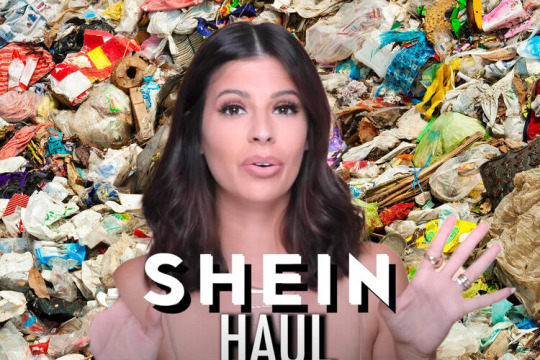
Operator ████: “I followed an influencer for two weeks. Every video, new outfits, new haul, new unboxing. I checked her resale account. The red jacket was up for sale last week. She didn’t even wear most of it.” Greenwashing is not an accident of marketing but a carefully constructed corporate strategy designed to mislead consumers while keeping the machinery of fast fashion running at full speed (Bick et al., 2018). H&M’s Conscious Collection and Zara’s Join Life line are prime example collections marketed as eco-friendly while the companies behind them continue to mass-produce clothing at an unsustainable scale (Finjan, 2024). Despite their claims, only a fraction of the materials used in these lines are actually recyclable; the rest still contribute to the growing waste problem (Brewer, 2019).

The industry presents it as a breakthrough in sustainable fashion, yet in reality, it merely extends the lifespan of plastic pollution under the guise of progress. Polyester made from recycled plastics still sheds microplastics with every wash, contaminating waterways and creating long-term pollution (Finjan, 2024). Some brands go as far as inventing their own sustainability certifications, presenting logos and labels that give the impression of strict environmental standards when, in reality, they are nothing more than marketing tools (Szabo & Webster, 2021). Operator ████: "We found clothes with tags still attached. Some had shipping labels and sustainability certificates that blurred. What were they meant for?"

Slow fashion was introduced as an antidote to the harms of fast fashion, emphasizing ethical labor, mindful consumption and sustainability. However, as the movement gained popularity, it was co-opted by capitalism, turning ethical fashion into a luxury rather than an accessible solution (Finjan, 2024). Many sustainable brands price their products so high that only wealthy consumers can afford them, creating an exclusivity barrier that contradicts the movement’s original intent (Jung & Jin, 2014). The concept of the "investment piece" , a timeless, high-quality item meant to replace fast fashion has become a marketing strategy, subtly encouraging consumers to keep buying (ibid). Another issue lies within the rise of slow fashion influencers, who, despite promoting sustainability, subtly reinforcing the idea that sustainable fashion still requires constant renewal, even if at a slower pace. This contradicts the core principle of reducing consumption altogether.
Operator ████: "We thought we were investigating a dumping ground. But this wasn’t a graveyard. It was a factory. A place where old trends rot and something new is born."

The horrors of this graveyard are not just environmental but social. The dumping sites have inadvertently created an informal economy, where impoverished communities scavenge through the textile mountains to resell what they can (Carvalho, 2023). Many of these individuals, including migrants from Venezuela and Bolivia, rely on the waste for survival, collecting and reselling clothes before authorities cover the sites with sand to obscure the scale of illegal dumping (Guardian News and Media, 2023). The situation is exacerbated by frequent fires, as discarded clothes are incinerated in attempts to erase evidence, releasing toxic fumes that seep into the air and soil (ibid). These burning garments, often laced with synthetic dyes and plastic-based fibers, pose serious health risks not only to those who live nearby but also to the broader ecosystem, as pollutants infiltrate underground water sources (ibid).
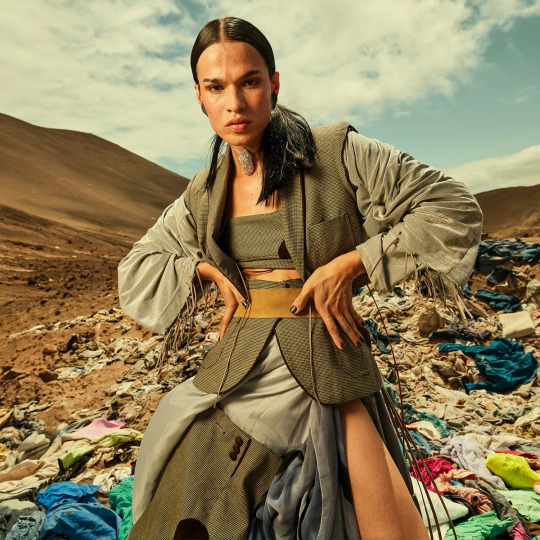
Many activists are raising awareness against this current issue. Maya Ramos, a stylist and visual artist from the state of São Paulo in Brazil teamed up with Fashion Revolution Brazil and Artplan to put on “Atacama Fashion Week” amid the rubbish to raise awareness of the reality she lives with and to illustrate what can be made out of the waste (Guardian News and Media, 2023). Models are dressed from burnt fabric scavenged from the smoldering remains of incinerated fast fashion pieces. The collection was themed around the four elements earth, fire, air, and water, each piece representing the devastation fashion waste has inflicted on the planet (ibid).
The Atacama serves as a stark warning: fast fashion does not disappear when we discard it. It simply moves to the margins of the world, where it festers, burns and poisons. As consumers, the illusion of guilt-free consumption, buying yet another “sustainable” collection, donating to an overflowing charity bin—only fuels the cycle. The question remains: when the desert is full, where will the next graveyard be?
References: ---------------------------------------------------------------------------
Bartlett, J., & Merino, T. (2024, March 5). Chile’s Atacama Desert has become a fast fashion dumping ground. National Geography. https://www.nationalgeographic.com/environment/article/chile-fashion-pollution
Bick, R., Halsey, E., & Ekenga, C. C. (2018). The global environmental injustice of fast fashion. Environmental Health, 17(1), 92. https://doi.org/10.1186/s12940-018-0433-7
Carvalho, M. C. B. N. de M. (2023). [en] fashion industry and its socio-environmental impacts: A critical perspective and case study in the Atacama Desert. Metadados do item. https://bdtd.ibict.br/vufind/Record/PUC_RIO-1_1463f37569eee7bfd584b16acdb9b5a9
Domingos, Mariana, Vera Teixeira Vale, and Silvia Faria. (2022). "Slow Fashion Consumer Behavior: A Literature Review" Slow Fashion Consumer Behavior: A Literature Review" Sustainability 14, no. 5: 2860. https://doi.org/10.3390/su14052860
Guardian News and Media. (2023, May 9). “there’s no water”: Migrants stranded in Chilean Desert as Peru closes border. The Guardian. https://www.theguardian.com/global-development/2023/may/09/migrants-stranded-chile-peru-border
Guardian News and Media. (2024, May 8). Castoffs to catwalk: Fashion show shines light on vast Chile clothes dump visible from space. The Guardian. https://www.theguardian.com/global-development/article/2024/may/08/castoffs-to-catwalk-fashion-show-shines-light-on-vast-chile-clothes-dump-visible-from-space
Jung, S. and Jin, B. (2014), A theoretical investigation of slow fashion. International Journal of Consumer Studies, 38: 510-519. https://doi.org/10.1111/ijcs.12127
Mark K. Brewer, ‘Slow Fashion in a Fast Fashion World: Promoting Sustainability and Responsibility’, Laws 2019, 8(4), 24
Rabolt, N., & Miler, J. (2018). Bloomsbury Fashion Central—Fast Fashion and the Environment: Is there a Solution? https://www.bloomsburyfashioncentral.com/businesscase?docid=b-9781474208796&tocid=b-9781474208796-045
Sonja Maria Geiger and Johannes Keller, ‘Shopping for Clothes and Sensitivity to the Suffering of Others: The Role of Compassion and Values in Sustainable Fashion Consumption, Environment and Behavior 2018, Vol. 50(10) 1119–1144. Click here.Download Click here.
Szabo, S., Webster, J. Perceived Greenwashing: The Effects of Green Marketing on Environmental and Product Perceptions. J Bus Ethics 171, 719–739 (2021). https://doi.org/10.1007/s10551-020-04461-0
2 notes
·
View notes
Text
the loss of a collective aesthetic
Every generation, or at least decade, is thought to have a distinct aesthetic. The 40s were utilitarian but still traditional until the New Look was introduced and dominated the 50s. The 60s saw the rise of skirt hemlines and British-mod inspired fashion, led by the new middle-class teen consumers. The 70s were earthy tones with 1940s inspired menswear inspiring womenswear. The 80s were vibrant and neon with over exaggerated hair, shoulder pads, and jewelry. The 90s, on the other hand, were led by minimalism, with some influences of grunge and goth. The 2000s were mainly gothic/preppy inspired. The 2010s were very 1950s inspired with their peplums and A-line skirts. But, by 2024, there is no distinct style we can assign this decade. Why is this?
Defying Categorization Under Increased Surveillance
As tech advanced in the 21st century and social media became prevalent among all demographics, surveillance increased too (Farah). There have been multiple cases where social media companies have stolen their users' information and categorized them to sell to third-party groups. One of the most recent cases is when millions of profiles were harvested from Facebook and given to a third-party party to benefit certain parties in the US 2016 presidential election and Brexit (Cadwalladr and Graham-Harrison). Facebook failed to alert these people even after learning of the data breach (Cadwalladr and Graham-Harrison). Most websites now require a subscription in which you are expected to happily hand over identifiable information like phone numbers, addresses, and credit cards. Some governments and police have begun using information from the internet to identify criminals, even though this may lead to serious racial profiling.
Like every generation before it, Generation Z’s instinct will be to go against mainstream culture. Past trends often had a select number of sub-trends. For example, in the 90s, counterculture fashion trends had sub-trends like grunge, punk, and goth. These people were easily categorizable due to the distinct elements found in one sub-trend but not another. This generation, most likely to avoid this categorization by institutions whose values are openly questioned, has blurred these sub-trends and promoted mixing-and-matching instead. Accordingly, there will not be one singular trend the majority of people will follow and companies have to abandon their “one-size-fits-all” approach to the youth (Farrah).
Incentivized fast fashion via social media algorithm
Social media, especially short-form social media platforms like TikTok and Instagram Reels, pays creators with affiliate links They also have their own online shopping tools like TikTok shop. Proportionately, more people want to be an influencer or content creator as a profession—57% of Gen Zers to be exact (Malinsky). For users, it has become incredibly easy to click and buy a whole new wardrobe without considering the impact of overconsumption ( Venkatraman). Also, since these platforms are largely short form, it means that creators are forced to compete for the users attention and engagement. As a result, they have to introduce new items on a rotary basis to keep their stats, resulting in multiple trends that rise and fall quickly. People feel the need to keep up due to the fear of being “cheugy,” which is the following of outdated 2010s trends (Venkatraman).
These micro-trends have also been amplified by fast fashion. Whether or not microtrends have caused fast fashion or fast fashion has caused microtrends can be debated. But, its impact on how easily people can buy into new trends monthly, or even daily, is undeniable. Fast fashion brands like Zara and Shien copy popular designs often seen on celebrities within a short time frame, sometimes as soon as 24 hours, and sell them for affordable prices. The promotion of overconsumption and its accessibility has allowed people to look widely different from each other. There is no longer one distinct trend that reins supreme.
Tech ruins attention spans and everything is blurred
Have you noticed how the major trends since the turn of the 21th century have not changed? By major trends, I mean the everyday clothes people wear. In schools, for instance, the common uniform for students, at least public school students, are pajama pants and hoodies. They lack the soul, as I would describe it, other generations had with their every-day clothes.
The environmental conditions for this generation are widely different from past generations. The 20th century oversaw chaotic events (Balugo). However, if you were trying to remember the events of the 20th century, you’d probably be able to name these events in order. With tech, though, time has sort of blurred. Algorithms and personalization of how and what news people get and ruined attention spans make this harder for the 21st century. This contributes to the lack of collectiveness we feel. Even old counterculture movements led to mainstream trends eventually (Balugo). But this took time—time you don’t have with microtrends!
In the 20th century, trends were more collective with older people engaging in trends like 80s neon (Balugo). It was not exclusive to teens, 30 year olds, or 60 year olds. Everyone had a similar aesthetic going on. Now, perhaps due to the increased amount of choice people have, older people do not join in on trends as they used to. This causes a divide between the looks of older and younger generations. Also, thrift stores, places where you can get one-of-a-kind items have become more popular and mainstream now. They are a way to access old trends and pull inspiration. This leads to individualistic choices that harm mass culture.
In conclusion, the loss of a collective aesthetic is a symptom of a much larger issue: the loss of true shared experiences. It’s not only sad that life has become so much more chaotic due to tech, fast fashion, and consequential digital surveillance, but it’s even sadder that society has in some ways deteriorated in ways that make it harder and harder to return it to the way it once was. There isn’t much more to say other than the days of buying quality clothing items for an affordable price in a local store are slowly being phased out, and with that comes the connection we have to an aesthetic. Share what you think below!
5 notes
·
View notes
Text
Slow Fashion in Vietnam: A Movement Gaining Momentum
Slow fashion is not just a trend; it's a shift in mindset. It's about valuing quality over quantity, investing in timeless pieces, and supporting sustainable practices. In recent years, the slow fashion movement in Vietnam has been steadily gaining momentum as consumers become more conscious of the environmental and social impacts of the traditional fast fashion industry. Fueled by a growing awareness of sustainable practices and a desire to support local artisans, Vietnamese brands and designers are embracing the principles of slow fashion and offering thoughtful, ethically-produced alternatives to the mass-produced garments that have long dominated the market.

Embracing Sustainable Practices
One shining example of the slow fashion ethos in Vietnam is Kilomet109, a Hanoi-based brand that showcases the country's rich textile heritage. Founded by designer Vu Thao, Kilomet109 meticulously crafts each garment, utilizing eco-friendly materials and traditional techniques (Ngo Quynh,2022). Their dedication to sustainability extends beyond the production process, as they actively promote environmental awareness and encourage responsible consumption habits among their customers.
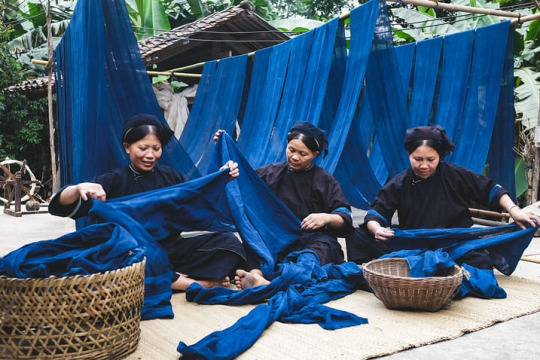
Another notable brand, Fashion4Freedom, shows the desire to use fashion to liberate and develop. Each F4F product is a true work of art thanks to its uniqueness in concept and processing. Dragon Shoes is an example. The sole of the shoe "takes advantage" of jackfruit wood purchased from local families, intricately carved. F4F also has many impressive products such as patterned costumes of the Ta Oi people, jewelry collections from phones and computers. and broken tablets, wooden jewelry... When looking at products from F4F, we have the right to be proud of a carving culture coming from traditional craft villages (Nhi Nguyen, 2022).

Environmental Benefits and Cultural Preservation
The environmental benefits of slow fashion in Vietnam are undeniable. Slow fashion brands typically utilize natural, organic materials like organic cotton, hemp, and Tencel. These materials require less water, energy, and harmful chemicals compared to conventional fast-fashion fabrics. Additionally, slow fashion emphasizes smaller production batches, minimizing textile waste, a significant environmental concern in the global fashion industry.
Furthermore, slow fashion in Vietnam celebrates and revitalizes traditional craftsmanship techniques. Many brands collaborate with local artisans who possess skills in weaving, dyeing, and embroidery passed down through generations. This not only preserves cultural heritage but also empowers local communities by providing sustainable livelihoods for artisans. Brands like Gia Studio, which uses natural dyes and handwoven fabrics to create traditional Vietnamese clothing, are examples of this cultural preservation (Pameyla Cambe,2024)

A promising for future
The slow fashion movement in Vietnam is still in its early stages, but it has the potential to make a significant impact on the global fashion industry. As more and more Vietnamese consumers embrace slow fashion principles, the industry is poised to play a significant role in reducing the fashion industry's environmental impact and promoting ethical labor practices.

The rise of slow fashion in Vietnam signals a promising shift towards more sustainable and socially responsible consumption. As this movement grows, it not only brings environmental and economic benefits but also strengthens the cultural fabric of Vietnamese society, weaving a future where fashion respects both people and the planet.
References
Cambe, P. (2024, April 2). Vietnamese Fashion Brand Gia Studios Is Crafting The Ultimate Minimalist Wardrobe. Grazia Singapore. https://grazia.sg/fashion/gia-studios-lam-gia-khang-vietnamese-fashion-brand-minimalist-interview/
Maker Profile: Kilomet109. (2017, September 21). THE KINDCRAFT. https://thekindcraft.com/kilomet109/
Nguyen, N. (2022, July 18). 5 thương hiệu thời trang việt bền bỉ theo đuổi sự bền vững. Vietcetera. https://vietcetera.com/vn/5-thuong-hieu-thoi-trang-viet-ben-bi-theo-duoi-su-ben-vung
Quynh, N. (2022). Top 10 thương hiệu thời trang bền vững nổi tiếng tại Việt Nam. Coolmate. https://www.coolmate.me/post/cac-thuong-hieu-thoi-trang-ben-vung-tai-viet-nam
4 notes
·
View notes
Text
Future Digital Assets: An Exploration of the Crypto Trends

The cryptocurrency world is constantly changing with significant improvements, regulatory changes and market movements prompting companies to either adopt or expand their existing business models. So, what are the trends that will define digital assets in the future?
Now: Rising adoption of digital currencies by the mainstream financial institutions as well as businesses marks the crypto market in 2024. While original cryptocurrencies like Bitcoin and Ethereum are still leading, new entrants come in with novel features.
AI & Cryptocurrency Trading: AI Advances in cryptocurrency trading with machine learning algorithms that can analyze the data, predict market movements, and execute trades accurately. This makes trade execution more efficient and reduces human error.

On Blockchain innovations — recent changes in the Engineering discipline of blockchains such as, sharding or layer-2 solutions that improve scalability, security, and interoperability are helping make blockchain more reliable and flexible.
Investment Strategies in Digital Assets: You need to become familiar with various investment strategies available in Crypto market which includes the trends of the market, risk management and a proper diversification. Keeping an eye on those Bitcoin price predictions and Ethereum 2.0 updates are key to making decisions.
Regulation: “Governments and regulators around the world pay more attention to cryptocurrencies”. With the regulatory environment changing quickly, it is important to appreciate both compliance and growth possibilities.

Decentralized Finance (DeFi) — By providing decentralized versions of every financial service, DeFi is replace them with trust-minimized and highly-resistant smart contracts to provide similar services. These amenities facilitate the direct lending, borrowing and trading of digital assets without intermediaries—thereby providing users with an increased degree of financial autonomy.
Market Trend and Forecast: A thorough market trend enables to grasp market dynamics, whilst making sure about the reported forecasts, get declared predictions. One of the few remaining concepts is the volatility of crypto markets affected by sentiment, regulatory news and technological advancements.
On the level of adoption, we are experiencing a gradual increase in use cases as more organizations now receive payments with this digital asset as well as their customers conducting transactions which are growing.

Blockchain and AI: Combining features of blockchain with the capabilities of AI -this collaboration maximizes data security, improves efficiency and facilitates smarter decision-making, which mean that it can support new generation paradigms in many different markets.
#economy#investing#investment#entrepreneur#personal finance#startup#bitcoin#blockchain#crypto#ethereum
4 notes
·
View notes
Text
Graphic Design Trends to Watch Out For in 2024
Minimalism Continues to Reign
Clean, uncluttered designs are still popular in 2024. Minimalism focuses on simplicity and functionality, allowing the core message to shine through. This trend is particularly effective for businesses that want to convey a sense of sophistication and elegance.
Typography Takes Center Stage
Typography is becoming increasingly important in graphic design. Designers are experimenting with unique fonts, custom lettering, and innovative typography techniques to create visually striking and memorable designs.
Bold and Vibrant Color Palettes
While minimalism is popular, there's also a growing trend towards bold and vibrant color palettes. These eye-catching color combinations can help a brand stand out and make a lasting impression.
The Rise of Hand-Drawn Illustrations
Hand-drawn illustrations are making a comeback in graphic design. They add a personal and authentic touch to designs and can help a brand connect with its audience on a deeper level.
Sustainability in Design
As consumers become more environmentally conscious, there's a growing demand for sustainable design practices. This includes using eco-friendly materials, reducing waste, and promoting ethical sourcing. When seeking Graphic Designing Services in Punjab , consider partnering with designers who prioritize sustainable practices and align with your brand's values.
#graphicdesign#designinspiration#graphicdesigner#design#visualdesign#creative#branding#typography#illustration#sangrur
2 notes
·
View notes
Text
EP Review - Here, Hear. IV – La Dispute (2024)
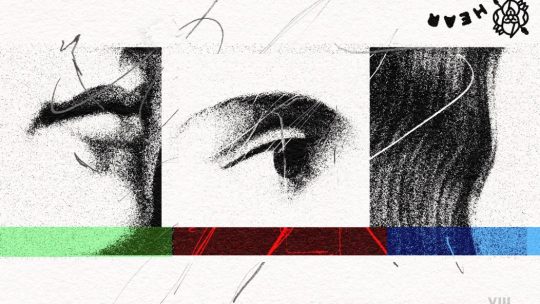
This EP was the best gift that 2024 could give me, and we're still only in March. A game between the traumas in the stories recounted in La Dispute's first "great" albums - Somewhere at the Bottom of the River Between Vega and Altair (2008) and Wildlife (2011) - revolutionary for the experimental world of midwest emo, post-hardcore and the underground community in general, and the latest works of art that are most listened to and reflected on, which tell us through the details of everyday life, feelings, landscapes and images open to the listener's imagination - Rooms of the House (2014) and Panorama (2019) - when recitation becomes part of the post-hardcore trends.
Despite the pained voice and the contrasts that create the perfect synthesis of the guitars and bass, the rhythmic coherence of the drums and the literary personality of the band that has always been faithful to us from the beginning until today, elements that have created the "brand image", I notice that these geniuses of emo music don't mind experimenting with new electronics, the absence of screams and distortions, love, new ways of saying things. The fact that we can't catalog and put aesthetic labels on certain artists, because they are constantly metamorphosing and contradicting themselves with the genres given by fans and record companies, certain types of festivals and events, algorithms of streaming platforms, etc., is a proof that the post-hardcore of these bands that continue to record over the years is maturing as a movement. And this EP has made me reflect on my generation, which adapts to trends by not adapting to it at all. Perhaps silences and improbable harmonic resolutions are the oxygen pump for artists and listeners of music created in a studio as if it’s a laboratory.
Here, Hear. is a collection of four volumes, the first of which was released in 2008, the band's big bang year. In the four volumes, we can see that La Dispute exploded at the beginning and took their own advantage of the sounds in a very genuine, pure and direct way, unashamed to use unconventional instruments such as pianos, maracas and “folklorized” melodies - always recognizable on a timbral level, anyway - but it was in this last one, sixteen years later, that we see the band flourish, not in an explosive way as before, but always pure and honest. They reinforce simplicity and the timeless stories. Sixteen, the fourth song on the EP, and one that had been released before on Spotify, marks a new life of La Dispute: it reminds me of the walks I had to school when I was fourteen and of my first crush had dedicated the song Such Small Hands (2008) to me in anonymity; of the song Woman (In the Mirror) (2014) when I was always at home trying to discover my own way of (always hidden) teenage happiness. Today I've discovered how happy I can be and that the nostalgia for the sadness, heartbreak and melancholy that went on in the corners of my neighborhood while I listened to La Dispute's entire discography for most of the years I lived there is part of it. We were sad listening to sad music, and happiness, today, is based on that. This single, according to my empirical experience and to the community of fans writing online as well, reminds us of those nostalgic times.
And the group's aesthetic minimalism continues. Not just in the music, but in the band's overall image. And I'm enjoying watching it. The lyrics and stories increasingly make sense, since the instrumental part of the EP makes them prevail. In the song Reformation, which concludes the EP in a mode of ecstatic tranquillity, we have a beautiful guitar that harps along with Jordan Dreyer's unsung and unshouted voice. Just like that. Everything that the music of sensitive people needed to offer about the art of growing up and noticing life's little symbols, even when you drink your coffee in the morning before facing the life of an adult who is emotionally trapped by the years that have passed.
«You awake at 3AM to the soft voice of her dream, saying
"These are the people who said that you like him would never die
Until you do and you will and I will too
Just like this, baby, but longer, forever
And there's nothing past that door, I know it"
Before she drifts back to sleep where you can't now and it's okay
Peace be with you»
Reformation, La Dispute (2024)
4 notes
·
View notes
Text
Im watching a camrip of Mean Girls 2024 and.... Jesus christ it's like they didn't even want to make a movie of the musical. So many good songs were cut for these awkward, amateur reenactments of the original movie scenes. Most of the cast seems like they can barely hold a note.
Other posts have already talked about how badly they sanitized the script/overall message so I don't need to even get into that but like?? The only reason people asked for this movie is because they wanted to see THE MUSICAL on screen. Nobody wanted a mediocre imitation of the old movie, we could just go back and watch that one whenever we want to because it still holds up. But every detail of this movie feels like there was no faith in the musical aspect being appreciated by the audience. Like they were so embarrassed to have songs in the movie at all, that even the music they did keep in was rearranged to sound as minimalized and nonchalant as possible.
Every second of Cady's songs sounds boring. Gretchen sounds like shes being rushed to finish her song so it can stop being a musical. Karen's song was fucking butchered even though framing it with the whole tiktok online trend thing could have really added to it. Literally the only song with any punch to it was World Burn. THEY TOOK OUT WHERE DO YOU BELONG/MEET THE PLASTICS ENTIRELY!!! IT COULD HAVE BEEN THE BEST PART OF THE MOVIE!?!
This movie is so afraid to be uncool/cringe that it defeats the entire purpose of making it in the first place. I know we like, been knew this, but Hollywood really is where art goes to die.
6 notes
·
View notes
Text
New XEC COVID subvariant poses potential threat heading into winter. Doctors urge vaccinations - Published Sept 23, 2024
By Rong-Gong Lin II
A new coronavirus subvariant is gaining steam and drawing more attention as a potential threat heading into late autumn and winter — a development that threatens to reverse recent promising transmission trends and is prompting doctors to renew their calls for residents to get an updated vaccine.
XEC, which was first detected in Germany, is gaining traction in Western Europe, said Dr. Elizabeth Hudson, regional chief of infectious diseases at Kaiser Permanente Southern California. Like virtually all coronavirus strains that have emerged in the past few years, it’s a member of the sprawling Omicron family — and a hybrid between two previously documented subvariants, KP.3 and KS.1.1.
Past surges have tended “to move from Western Europe to the East Coast to the West Coast of the U.S.,” Hudson said. “So if this does take off more and more as we get towards the colder weather months, this probably would be the variant that will potentially take hold.”
XEC hasn’t been widely seen nationally so far. According to the U.S. Centers for Disease Control and Prevention, KP.3.1.1, a descendant of the FLiRT subvariants, is the dominant circulating strain nationwide. For the two-week period ending Sept. 14, KP.3.1.1 was estimated to comprise 52.7% of the nation’s coronavirus specimens.
XEC, by comparison, isn’t yet being tracked on the CDC’s variant website. A subvariant needs to make up an estimated 1% or more of coronavirus cases nationwide to qualify.
But there are estimates that XEC makes up 13% of coronavirus samples in Germany and 7% in Britain, said Dr. Peter Chin-Hong, a UC San Francisco infectious diseases expert.
“We’ll have to see how things go. If this does take off, probably we would start to see it more like November, December time,” Hudson said. “So like after Halloween — when the weather will probably get more reliably cool here, people start to go indoors more often — that’s when we’re more likely to see this potentially take hold.”
Any fall or winter resurgence, which has become a reliable occurrence ever since the emergence of COVID-19, would follow a prolonged summer surge that surprised doctors and experts with its strength.
One silver lining, though, is that the timing and strength of the summer COVID surge probably means it could be a couple of months before many people become more susceptible to reinfection, Chin-Hong said.
Last winter’s COVID peak in California — in terms of viral levels in wastewater — was the first week of January.
After the surprisingly strong summer surge, COVID is now declining or probably declining in 22 states, including California and Texas, as well as the District of Columbia, the CDC said Friday.
The COVID trend is stable or uncertain in another 22 states, including Florida and New York. COVID is projected to be growing or probably growing in New Jersey, Washington and Massachusetts, and there was no data for the three remaining states.
Still, new COVID infections remain relatively high in many parts of the country. Coronavirus levels in wastewater are still considered “high” or “very high” in 40 states, including California, Texas, Florida, Illinois, Pennsylvania and Ohio, the CDC said Friday. They were categorized as “low” or “minimal” in six states, including New York, Michigan, Nevada and Hawaii.
In Los Angeles County, coronavirus indicators are on a downward trend. For the 10-day period that ended Sept. 7, the most recent available, coronavirus levels in wastewater were at 56% of last winter’s peak. That’s down from the 10-day period that ended Aug. 24, when viral levels were at 75% of last winter’s peak.
An average of 239 coronavirus cases a day were reported for the week that ended Sept. 15, down 31% from the prior week. Officially reported coronavirus cases are an undercount, as they don’t factor in tests done at home or account for the fact that many people aren’t testing at all when sick. But the trends are still useful in determining how a COVID wave is progressing.
The share of emergency department visits classified as coronavirus-related in L.A. County was 2.8% for the week that ended Sept. 15, down from 3.5% the prior week.
The average number of COVID-19 deaths, however, is rising — an expected development given the surge in illness and the lag in reporting fatalities. An average of 4.9 COVID deaths were reported per day for the week that ended Aug. 27 in L.A. County, up from the prior week’s number of 4.3.
COVID levels in the wastewater of the San Francisco Bay Area are also settling down. Coronavirus levels were considered medium in the sewersheds of San José and Palo Alto, and low in Sunnyvale and Gilroy, the Santa Clara County Public Health Department said.
The rate at which coronavirus tests are coming back positive is falling in California. For the week that ended Sept. 16, 8.9% of reported coronavirus tests — typically those done at medical facilities — returned positive results. The seasonal peak was 12.8%, for the week that ended Aug. 10, according to the latest data.
It remains unclear how bad this winter’s respiratory virus season will be. COVID isn’t the only game in town, as health officials also are closely monitoring flu and respiratory syncytial virus, or RSV.
The CDC in late August forecasted that this fall-and-winter season will either be similar to last year, or perhaps slightly less potent. But that forecast could be overly optimistic, the agency warned, if some assumptions are off — such as if fewer people get vaccinated than expected.
The situation may be improved because people may still have some residual immunity from flu and RSV, Chin-Hong said, which flared up the past couple of winters. Also helping matters is the rollout of vaccines against RSV, which became available last year.
Still, every winter carries its own respiratory illness risk. Circulation of a type of flu that’s different than the ones included in the vaccine would make those shots less effective, for instance.
And the experience from parts of the Southern Hemisphere for their winter suggests the respiratory virus season could be active here, Hudson said.
“Australia — they had a pretty robust and early flu season, and we are already starting to see a couple of cases of flu here in the U.S., which is pretty darn early,” Hudson said.
The CDC recommends that everyone 6 months old and older get the updated COVID-19 and flu vaccines. The immunizations are widely available, and the best time to get vaccinated is in September and October, the CDC says.
After a coronavirus infection, people may consider waiting three months to get the latest COVID vaccination, according to the CDC. But people can also choose to get it as soon as they feel better.
“I always have hope. And if folks get vaccinated — this is the perfect time now to get vaccinated against flu, get the new COVID shot — we could potentially tamp down on what will certainly be another more typical fall-and-winter surge. But I think the jury is out in terms of how bad it is going to be,” Hudson said.
Getting vaccinated “means fewer sick days and more time with your loved ones. We are stronger when we are all protected against respiratory diseases,” Dr. Tomás Aragón, the director of the California Department of Public Health, said in a statement.
Older or immunocompromised people who haven’t been vaccinated in more than a year are at highest risk for severe COVID illness and death, officials say.
Data show that people who got last year’s updated COVID vaccine were 54% less likely to get the disease between mid-September 2023 through January, according to the CDC.
A flu vaccine that’s well matched to the circulating viruses can also reduce the likelihood of becoming sick enough to require a doctor’s visit — by 40% to 60%, the CDC said.
There are needle-free options for getting the flu vaccine, such as FluMist, which has been available for many years as a nasal spray for non-pregnant people ages 2 to 49. On Friday, the U.S. Food and Drug Administration approved at-home use of FluMist — meaning adults can administer the vaccine to themselves or their children.
A prescription will still be needed for the at-home option, which is expected to be available starting fall 2025.
COVID remains a greater risk to public health than the flu, the CDC says. Since Oct. 1, at least 55,000 COVID-19 deaths have been reported nationally. At least 25,000 flu deaths are estimated over that same time period. Flu death estimates are expected to be updated in October or November.
The CDC recommends RSV vaccinations for all adults age 75 and older, as well as those ages 60 to 74 who are at increased risk for severe disease. The RSV vaccine, however, is not annual, so people who got one last year don’t need to get another one at this time.
An RSV vaccine is also available for expectant mothers at weeks 32 to 36 of pregnancy to pass protection to their fetuses. An RSV antibody is available for babies and some young children, too.
The U.S. Department of Health and Human Services said it will again make four free COVID tests available through the mail for households. You can register at covidtests.gov starting at the end of September.
Besides getting vaccinated, California health officials urged people to take other steps to prevent getting sick and infecting others. They include staying home when sick, testing for COVID and flu if you’re sick, wearing a mask in indoor public settings, washing hands, covering cough and sneezes, and ventilating indoor spaces.
#mask up#covid#pandemic#covid 19#wear a mask#public health#coronavirus#sars cov 2#still coviding#wear a respirator#XEC variant
14 notes
·
View notes
Text
Home Decor in 2024. What’s Hot & What’s Not?

Pink’s out. Peach is in.
Pantone’s Color of the Year for 2024 is soft and subtle “Peach Fuzz,” replacing last year’s vibrant “Viva Magenta.” Pantone is recognized globally as a leading source of color expertise.
“In seeking a hue that echoes our innate yearning for closeness and connection, we chose a color radiant with warmth and modern elegance,” says Leatrice Eiseman, Executive Director of the Pantone Color Institute™.
If you’re looking to revamp your space, consider PANTONE 13-1023 and its complementary colors: everything from creamy, brown and tan neutrals to shades of teal, lavender and mint green. Note: gray is not listed. For those who went wild with gray or greige tones during that trend, you might want to roll up your sleeves and buy a new paint roller.
What’s out?
Say goodbye to Barbiecore (think pink). What else is losing favor? Here’s a quick rundown of trends that seem to be going by the wayside in home decor:
Sliding barn doors (Let’s face it – they don’t even do a great job of blocking light, smells, and sounds.)
White-on-white kitchens
Extremes – whether that means bare minimalism or over-the-top Grand Millennial
Heavy industrial style
What’s in?
Back kitchens
AKA butler’s pantry or scullery, this separate space keeps secondary or backup items hidden from site, tidying up the more public area. Here you can house additional refrigeration and freezing, warming drawers, wine storage, lesser-used mechanical devices, formal entertaining dishes and cutlery, etc. Appliance garages have been around for a while, but they seem to be gaining popularity as another way to streamline kitchens.
Bespoke bedrooms and bathrooms
Behind the scenes, highly personalized spaces offer homeowners comfort and creative freedom. Feel free to layer these rooms with your favorite monogrammed fabrics, artwork, family photos, and heirlooms. Make it meaningful.
Casual luxury
It may sound like an oxymoron, but luxury doesn’t have to mean formal. Rather than opulent and imposing, choose comfortable, lived-in furniture that is still beautiful and lavish.
Bold wall treatments
Add depth and personality to walls by treating them as large canvases. Incorporate wallpaper, paneling, 3D wall coverings, stone or wood features, decorative molding. This is a take on dopamine decor – which continues to be popular – creative touches that make you feel good when you walk into a room.
Separated spaces
Demolishing interior walls to create all-in-one living/working/playing areas is seeing a bit of a reversal. Delineating spaces by incorporating walls that still have good flow through the use of doorways and openings allows for rooms with purpose and intention.
Mixed metals
This may come as a relief. Chrome, brass, black, copper, bronze – all can be used when harmoniously paired. Trying to keep up with what’s in shouldn’t mean having to change out plumbing fixtures annually!
Mixed materials
Kitchen countertops don’t have to be one solid matchy-matchy mass. Add interest and dimension to this horizontal space. Consider a mix of materials for visual, tactile and utilitarian variety – natural wood with granite, or quartz with sleek stainless steel.
Outdoors in
Windows seem to be taking center stage – becoming bigger and bigger. The view outside is more of a focal point than an after-thought. Biophilic design is also a way to get the feeling of nature inside your dwelling by adding large indoor plants and natural wood and stone finishes.
Mud-laundry rooms
Combining a laundry with a mudroom is a space-efficient idea. Storage components can serve double-duty: hooks, cabinets, cubbies and drawers.
Sustainability
Cheap, mass-produced furniture is becoming increasingly unpopular. People are gravitating toward quality pieces that are higher end and/or repurposed for a lesser environmental footprint.
A word of caution
Before you revamp your space with all the latest trends, carefully consider which ones truly work for you. If you’re thinking about selling your home soon, reach out to me and let's talk about what changes will give you the biggest bang for your buck.
#jamierichards#realtorjamier#realestatetips#realestateagent#realestate#realtor#home decor#homedesign#interior design#interiordecor#interiors#decor#homeownership#homeowner#homeowners#2024#2024 trends#trends#trending#design trends
2 notes
·
View notes
Text
What’s Hot in 2024: Trends in Custom Wine Cellar Design

Wine cellars have always been a great way to store and show off your wine collection. In 2024, custom wine cellars are becoming even more stylish, modern, and luxurious.
Let’s take a look at the newest trends in wine cellar design that are taking over the industry.
1. Custom Glass Wine Cellars
One of the biggest trends in 2024 is the custom glass wine cellar. These wine cellars use glass walls, making it easy to see the wine bottles inside.
The clear glass adds elegance and beauty to any room. It also allows light to flow through the space, making it look bigger and brighter. People love these glass wine cellars because they combine style and function.
Question: What makes glass wine cellars special?
Answer: Glass wine cellars are stylish and let you see your wine collection. They add a modern, sleek look to any room.
2. Luxurious Wine Cellars
Luxury is always in style, and this year, it’s all about creating a space that feels like a high-end wine-tasting room. Many people are adding features like plush seating, wooden shelving, and elegant lighting.
They want their wine cellar to be a place for relaxing and enjoying a glass of wine with friends or family.
Question: What are luxurious wine cellars like?
Answer: Luxurious wine cellars are designed to feel special. They have soft seating, beautiful shelves, and warm lighting that makes the space look classy.
3. Modern and Minimalist Designs
More people are choosing clean, modern designs for their wine cellars. Instead of big, complicated setups, they prefer sleek, simple designs that focus on the beauty of the wine bottles. This minimalist style makes the wine collection the main focus of the room.
Question: What does a modern wine cellar look like?
Answer: A modern wine cellar is simple and neat. It focuses on the wine collection with clean lines and minimal decorations.
4. Wine Cellar Design with Wood
Wooden wine racks and shelves are still a favorite choice for many. In 2024, people are mixing wood with other materials like glass and metal to create beautiful, unique designs.
Wood adds a warm, natural feel to a wine cellar, making it a cozy space.
Question: Why is wood used in wine cellars?
Answer: Wood gives wine cellars a warm and natural look. It makes the room feel cozy and welcoming.
5. Wine Cellar Builders Using Smart Technology
Technology is also becoming a big part of wine cellars. Wine cellar builders are now adding smart features that can control the temperature and humidity.
This ensures that wine is stored in the best conditions. Some wine cellars even have lighting and climate control that you can adjust with your phone!
Question: How can smart technology help in wine cellars?
Answer: Smart technology controls the temperature and humidity, helping to store wine in perfect conditions. Some systems can be controlled by your phone!
6. Custom Wine Cellars in Miami-Dade County
In Miami-Dade County, custom wine cellars are getting more popular. Homeowners want a wine cellar that fits perfectly into their home, so they choose custom designs.
Whether it’s a modern, glass wine cellar or a luxurious, wood-filled room, these custom spaces are made to match the style of the home.
Question: Why are custom wine cellars popular in Miami-Dade County?
Answer: Custom wine cellars are popular because they are designed to fit perfectly with a home’s style and needs, giving homeowners a space that’s both beautiful and practical.
7. Function and Style Combined
Today’s wine cellars are more than just storage spaces. They are designed to be beautiful and functional.
Whether it’s a small wine fridge or a large room, these spaces are built to make wine storage easy and accessible. Plus, they are a great place to entertain guests or show off your collection.
Question: What makes wine cellars functional and stylish?
Answer: Wine cellars are built to store wine properly, while also being a stylish space for relaxation or entertaining guests.
Conclusion: Design Your Dream Wine Cellar
The latest trends in custom wine cellar design focus on combining luxury, technology, and style. Whether you’re interested in a glass wine cellar, a luxurious design, or a minimalist space, the possibilities are endless.
A custom wine cellar not only adds value to your home, but it also gives you a special place to enjoy your wine collection.
Learn more about: Trends in Custom Wine Cellar Design.
#Custom Wine Cellars in Miami-Dade County#Wine Cellar Builder#Wine Cellar Design#Custom Glass Wine Cellar#Luxurious Wine Cellars
0 notes
Text
From Diagnosis to Treatment: The Expanding Role of Endoscopy in South Korea
South Korea Endoscopy Devices Market Growth & Trends
The South Korea Endoscopy Devices Market size was estimated at USD 368.09 million in 2023 and is projected to register a compound annual growth rate (CAGR) of 9.48% from 2024 to 2030. The growth in minimally invasive surgical technologies is expected to boost the demand for endoscopic procedures. The emergence of capsule endoscopes and robot-assisted endoscopy has increased the demand for minimally invasive endoscopic surgeries (MIS). Innovations in endoscopic visualization systems and operative devices is anticipated to drive the market further. The increasing number of healthcare facilities, including hospitals, oncology specialty clinics, and cancer centers, is leading to a rise in the need for endoscopy devices. Furthermore, advancements in healthcare infrastructure and adoption of technologically advanced endoscopy systems is anticipated to bolster the market growth.
The adoption of endoscopy devices for clinical diagnosis and therapeutic interventions across various diseases is rising. These devices enable minimally invasive surgeries, leading to quicker patient recovery and fewer post-operative complications. By utilizing smaller incisions and minimizing muscle disruption, endoscopic procedures help preserve tissue integrity, thereby reducing complications for both patients and healthcare providers. Furthermore, they offer cost-effective alternatives to open surgeries, resulting in shorter hospital stays, faster recovery times, and reduced blood loss during procedures.
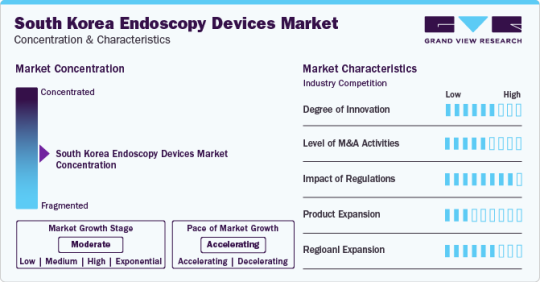
Since the introduction of the National Health Insurance Service (NHIS) in 1989, per capita healthcare expenditure in South Korea has been increasing. According to OECD Health at Glance, in 2023, South Korea spends USD 4,570 on healthcare per capita. Despite this, healthcare costs in Korea are acknowledged as being relatively low for healthcare providers. Consequently, this focus on quality and cost reduction in medical care is crucial from an economic perspective, as it allows consumers to purchase healthcare services according to their requirements while simultaneously ensuring providers are compensated sufficiently to maintain and improve their services, thus positively impacting the growth of the healthcare market.
South Korea has one of the highest life expectancies in the world, according to a BBC report in 2019, leading to an increase in the geriatric population in the country. According to Statistics Korea news article published in March 2023, the geriatric population in the country is forecasted to exceed 10 million individuals in 2024 and would increase by 5.4% compared to 2023. However, the early detection and management of geriatric ailments is still in development due to infrastructural and regulatory shortcomings. To address the diverse healthcare needs of the elderly, an integrated care approach is crucial. This approach involves coordinating various healthcare services, including preventive and rehabilitative measures, to ensure comprehensive and personalized care for older adults.
Curious about the South Korea Endoscopy Devices Market? Download your FREE sample copy now and get a sneak peek into the latest insights and trends.
South Korea Endoscopy Devices Market Report Highlights
Endoscopy visualization components led the market revenue share at 36.07% in 2023. This is attributable to the country’s substantial investment in research and development, resulting in innovative medical devices.
The endoscopes segment is anticipated to grow at a lucrative CAGR over the forecast period.
The gastrointestinal (GI) endoscopy segment led the market revenue share with 55.52%.
The urology endoscopy (cystoscopy) segment is expected to grow fastest over the forecast period, owing to demographic changes and technological advancements.
Hospitals dominated the market share, with a revenue share of 46.73% in 2023. This is attributable to the increasing number of surgeries performed in hospitals and the robust healthcare infrastructure, particularly associated with hospitals, in the country.
South Korea Endoscopy Devices Market Segmentation
Grand View Research has segmented the South Korea endoscopy devices market report based on product, application and end-use:
Product Outlook (Revenue, USD Million, 2016 - 2030)
Endoscopes
Rigid Endoscopes
Laparoscopes
Arthroscopes
Ureteroscopes
Cystoscopes
Gynecology Endoscopes
Neuroendoscopes
Bronchoscopes
Hysteroscopes
Laryngoscopes
Sinuscopes
Otoscopes
Sigmoidoscopes
Pharyngoscopes
Duodenoscopes
Nasopharyngoscopes
Rhinoscopes
Flexible Endoscopes
Laparoscopes
Arthroscopes
Ureteroscopes
Cystoscopes
Gynecology Endoscopes
Neuroendoscopes
Bronchoscopes
Hysteroscopes
Laryngoscopes
Sinuscopes
Otoscopes
Sigmoidoscopes
Pharyngoscopes
Duodenoscopes
Nasopharyngoscopes
Rhinoscopes
Colonoscopes
Disposable Endoscopes
Laparoscopes
Arthroscopes
Ureteroscopes
Cystoscopes
Gynecology Endoscopes
Neuroendoscopes
Bronchoscopes
Hysteroscopes
Laryngoscopes
Sinuscopes
Otoscopes
Sigmoidoscopes
Pharyngoscopes
Duodenoscopes
Nasopharyngoscopes
Rhinoscopes
Colonoscopes
Capsule Endoscopes
Robot Assisted Endoscopes
Endoscopy Visualization Systems
Standard Definition (SD) Visualization Systems
2D systems
3D systems
High Definition (HD) Visualization Systems
2D systems
3D systems
Endoscopy Visualization Component
Camera Heads
Insufflators
Light Sources
High Definition Monitors
Suction Pumps
Video Processors
Operative Devices
Energy Systems
Access Devices
Suction & Irrigation Systems
Hand Instruments
Wound Retractors
Snares
Application Outlook (Revenue, USD Million, 2016 - 2030)
Gastrointestinal (GI) Endoscopy
Laparoscopy
Obstetrics/Gynecology Endoscopy
Arthroscopy
Urology Endoscopy (Cystoscopy)
Bronchoscopy
Mediastinoscopy
Otoscopy
Laryngoscopy
Other Applications
End-use Outlook (Revenue, USD Million, 2016 - 2030)
Hospitals
Ambulatory Surgery Centers/Clinics
Other End-users
Download your FREE sample PDF copy of the South Korea Endoscopy Devices Market today and explore key data and trends.
0 notes